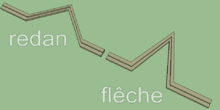Flèche (fortification)
A flèche (Fr. for "arrow") is an outwork consisting of two converging faces with a parapet and an open gorge, forming an arrowhead shape facing the enemy.[1]

Sketch showing the principle of a redan and flèche
The flèche is similar in plan to other defensive works like the ravelin or demi-lune, but smaller and built in front of the glacis. It was thus part of the outworks of a fortress. It was usually placed in front of the point of a bastion in order to create an additional level of fire.
See also
References
- A Dictionary of Military Architecture Fortification and Fieldworks from the Iron Age to the Eighteenth Century by Stephen Francis Wyley. Retrieved 23 May 2015.
Literature
- Horst Wolfgang Böhme, Reinhard Friedrich, Barbara Schock-Werner (eds.): Wörterbuch der Burgen, Schlösser und Festungen. Reclam, Stuttgart, 2004, ISBN 3-15-010547-1
- Wolfgang Klefisch: Die Neuendorfer Flesche – Vom Festungsmodell zum neupreußischen Festungswerk. Bornheim (Rhl) 2006 (3rd edn.)
This article is issued from Wikipedia. The text is licensed under Creative Commons - Attribution - Sharealike. Additional terms may apply for the media files.